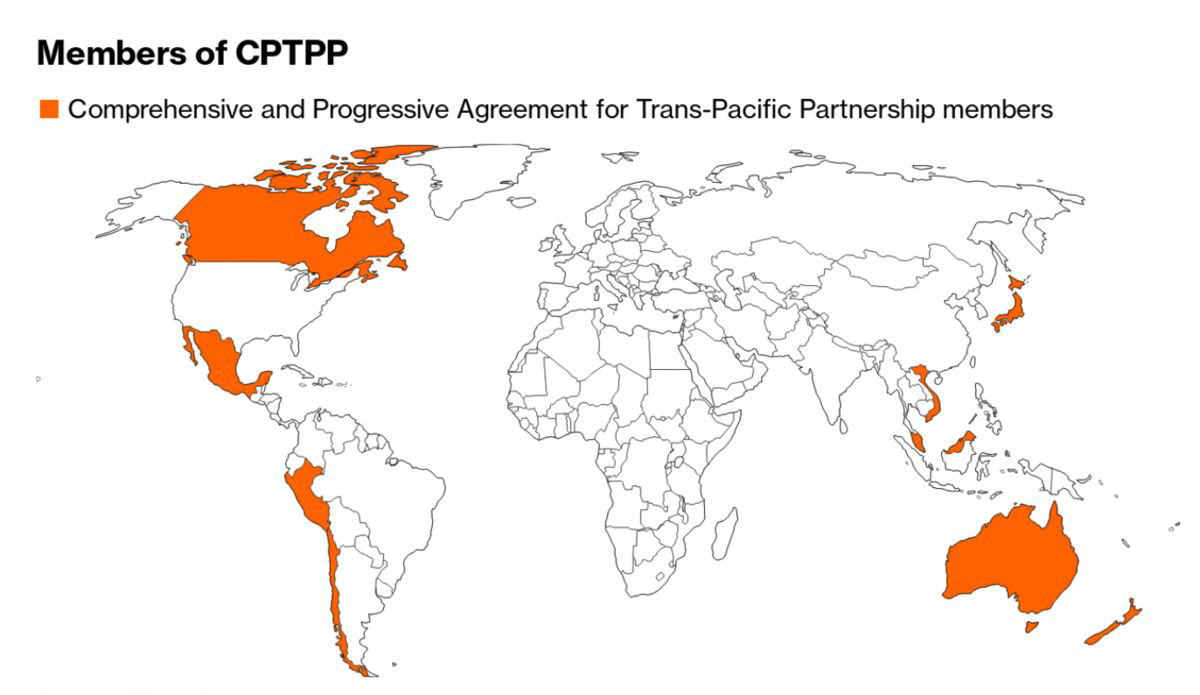Uk-sailing Into the Indo-pacific?
April 15, 2023 | Expert Insights

The Comprehensive and Progressive Agreement for Trans-Pacific Partnership (CPTPP) is the culmination of a long effort to connect the Asia-Pacific economic region with the wider world.
This fits in nicely with the UK’s present economic and strategic objectives. After the devastating impact of Brexit, the UK economy is searching for a stable balancing force to attach itself to. The CPTPP could be one such opening for the British confronted by falling incomes and a hostile EU.
Background
The British economy has been in an identity crisis ever since it left the protective cover of the EU economic system following Brexit.
The UK government has followed many strategies to replace the economic vacuum left by Brexit. First, it looked towards the English-speaking Commonwealth countries to become its economic partners in a new era. This did not turn out quite as planned. Most Commonwealth does not find it lucrative enough to do business with a relatively small market like the UK when China provides greater opportunities. The other option for London was a free trade deal with the United States. But here also, hopes were belied. The U.S. placed Britain last on the list of countries with which it wants a free trade agreement. The Americans are also concerned about the political status of Northern Ireland after Brexit.
The CPTPP is the second attempt to achieve the same objectives of a previous multilateral agreement, which failed. This was the Trans-Pacific Partnership (TPP). This deal was scuttled before it even got off the ground. The main spoiler here was none other than the United States. Americans have traditionally been wary of multilateral deals that give outsiders too much power. The TPP agreement was no exception in this regard. Both Democrats and Republicans across the aisle were suspicious about the TPP. As a result, the TPP could not be ratified and did not enter into force. It died a quick death.
Thus began the birth of the TPP’s successor, the CPTPP. CPTPP also followed the same convoluted procedures and heartbreaks at the preliminary stage as the TPP. The basic issues stalling progress on this deal were pretty much the same as before. It was how much countries, especially those in the developed, Western world, were willing to hand over control of key sectors of their economy to a multilateral partnership.
Protectionism has been a feature of Western economies for a long time. This has been especially true since the process of globalization began around the world. Western economies have no problem penetrating less developed economies through multi-national corporations (MNCs). But when their own economic sovereignty is threatened, they pull themselves back. The negotiation stage of the CPTPP was no exception. Here the developed country which put up a stumbling block was Canada. Canadian objections were based on the possible impact this deal would have had on its automotive industry and its culture. Eventually, Canada did join the CPTPP despite all its objections. All this delaying tactic did was slow down the negotiating process.
The CPTPP succeeded where the TPP had failed for several reasons. The most obvious reason is that it did not follow the traditional model of a trade agreement. There were many problems with the TPP. This included the fact that much of its discussions were conducted behind closed doors. This naturally aroused the suspicions of those who already had preconceived negative notions about this deal. The CPTPP overcame this shortcoming by keeping its negotiations as open as possible. Thus, people were less likely to make wild guesses about the CPTPP arrangement, and they could see the deal taking shape in front of their eyes.
The text of the TPP was also long and complicated, and this increased fears that it could be used for doing things for which it was not intended in the first place. There is a greater chance that unsavoury global interests can manipulate a long and complicated text more easily. The CPTPP has tried to bypass this problem by keeping things to the point and simple. It has tried to respect countries' economic sovereignties rather than infringe upon them.
The CPTPP is basically an economic conglomeration of the important middle powers in the world. It clearly shows that economic cooperation between different countries is possible without the presence of the world’s lone superpower. The United States could not overcome its inherent bipartisan suspicion of this treaty to move ahead. The other negotiating players in this treaty were no longer willing to wait for U.S. approval. They saw this as an opportunity to prove their economic independence from America. These countries still believe in the promise of economic globalization and have not given up hope here. So, it is quite appropriate for another middle power like the UK to join this grouping after being badly bruised by Brexit.
In this sense, Britain will be joining a collection of like-minded countries. All these countries want to link up economic trade with wider issues like climate change and intellectual property rights. They seek a more comprehensive approach to carrying out trade transactions instead of relying on the old and tested formulas, which are no longer valid in a rapidly changing world.

Analysis
The most direct beneficiary of the UK joining the CPTPP will be the British people.
The Asia-Pacific region is the world's most dynamic economic centre point right now, and most of the signatories of the CPTPP are a part of this region. Therefore, the CPTPP is seeking to connect the economic beating heart of the world with the rest of the planet.
If the UK gets more in compliance with global climate change mitigation norms through its participation in the CPTPP, then it's better for the world. A large number of countries in the Asia-Pacific region are vulnerable to climate change. They cannot wait to bring their trade practices in line with climate protection regulations.
China has also shown a certain willingness to join the CPTPP. But this has still not gone anywhere. This is primarily due to opposition from the two main powers in the CPTPP, Australia and Japan.
This shows that the middle powers of the CPTPP not only want to break out from the economic stranglehold of the United States, but they are also wary of the economic hegemony of Beijing. This is to prevent any inadvertent incidents from taking place between the two sides due to misunderstandings. These countries consider the CPTPP a rules-based trading system where everyone has an equal stake in making it work. China definitely does not fit the bill in this regard. It is seen more as an economic disruptor than an economic conciliator. That is why most countries in the CPTPP are suspicious of Beijing’s intentions and do not want it to become a member.
The UK joining the CPTPP has not only an economic impact but also a geo-strategic one. Following a fresh review of its defence policy, the UK government has already emphasised the Asia-Pacific region more. This is despite the fact that this region is far from Britain and there have been some severe cutbacks in the British defence industry. The other part of this treaty is carrying out bilateral and multilateral military exchanges with like-minded powers in the region. This is the overall British strategy of projecting its power and influence in far-off places in the world.
Countries bordering the Asia-Pacific region will also benefit from greater British engagement with the region. This includes India. New Delhi can trade more with the UK as the British slowly become an Asia-Pacific power after joining the CPTPP. But this is not all. India now has a greater incentive to increase its own engagement with the Asia-Pacific region following this major geo-political change of the UK becoming a member of the CPTPP.
Assessment
- The UK has to meet the strict trade conditionalities of the CPTPP when it becomes a member. Considering its current economic hurdles, this will take time as the negative impact of Brexit will not be immediately ameliorated following the UK's accession to the CPTPP.
- Overall, UK’s addition to the CPTPP is an overall victory for free trade and globalization. The UK will join the CPTPP not as a dominant power but on the same level playing field as other countries, and it will be a rule-taker, not a rule maker.
- The CPTPP confronts India with challenges that are difficult to overcome. While it has been pushing bilateral trade deals with most of the CPTPP members, it will lack a common platform to influence outcomes of economic debates that may ultimately produce decisions inimical to its economic interests. Just like in the case of the RCEP, India finds that the economic concessions that CPTPP demands are presently beyond its acceptance.








Comments